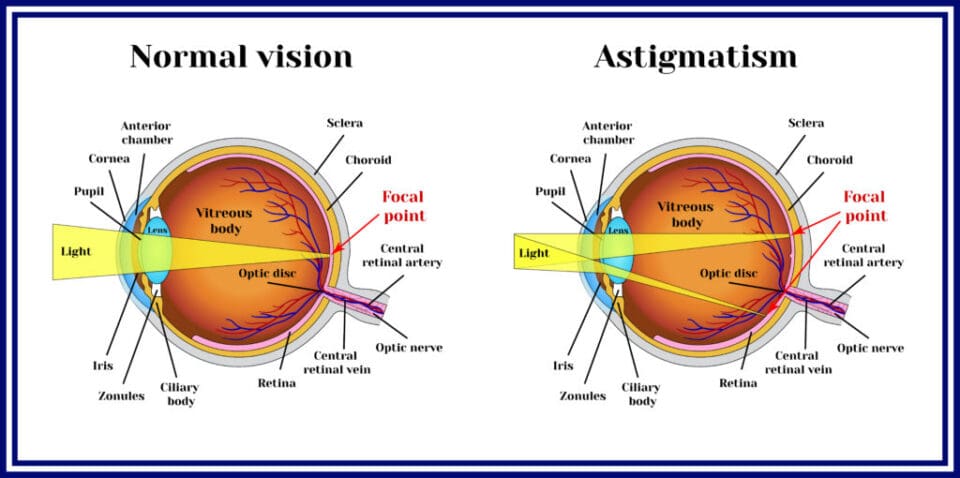How Do You See the World if You Have Astigmatism?
Home / LASIK for Astigmatism /
Last Updated:
Imagine a video recorded through through a camera lens that’s not quite clear, where lines seem wavy, and lights seem to have a radiant glow or streak. Objects, both near and far, may appear blurred or slightly distorted. In adverse lighting conditions, with bright lights like those from oncoming vehicles or streetlamps, making streaks and blurs.
This is a glimpse into the world of someone with astigmatism, an eye condition where an irregular corneal shape alters the usual clarity of vision, making the world seem a tad out of focus.
Astigmatism is a type of refractive error occurring in the cornea, that affects how the eye bends light. This causes blurriness, so the images you are looking at appear fuzzy and unclear. Many people (40% estimate) have this condition to some degree, but there are widely different levels of severity.
If astigmatism is making it hard to see clearly, there are treatment options. Corrective lenses are the most common treatment. You may also qualify for LASIK surgery for astigmatism.
How Does Astigmatism Affect the Eyes?

The eyeball, nature’s camera, senses images by admitting focused rays of light through the pupil in front to project to a focal point at the back of the eyeball, like a projector screen pointed right around the optic nerve. With astigmatism, the lens at the front is shaped differently, or contains other flaws, which cause the light rays to miss their target.
Unlike a healthy eye with a round cornea (the clear front surface of the eye), in astigmatism, the cornea may be shaped more like a football or an egg, with varying degrees of curvature. The irregular corneal shape causes light rays to be refracted, or bent, unevenly as they enter the eye.
You deserve clear vision. We can help.
With 135+ locations and over 2.5 million procedures performed, our board-certified eye surgeons deliver results you can trust. Your journey to better vision starts here.
As a result, the light does not focus properly on the retina, which is the light-sensitive tissue at the back of the eye. Instead of forming a single, clear image, the light focuses on multiple points on the retina, leading to blurred or distorted vision.
Astigmatism is more of a hindrance under certain conditions. Symptoms of this condition may present as:
- trouble reading fine print
- trouble making out detail at various distances
- poor night vision
- frequent headaches
- squinting
- eye strain
- sensitivity to light
What Are The Impacts of a Astigmatism?

Most people with astigmatism find it easy to correct with an eyeglass prescription. There’s a good reason some 4 billion people worldwide wear corrective glasses. Glasses are so common that we’ve even managed to turn eyewear into a hip fashion statement.
Naturally, it follows that many more astigmatism patients opt for contact lens wear, and just a small fraction opt for surgical solutions. It all comes down to the diffractive error of the natural lens and cornea. These methods help to adjust the way light enters the eye, compensating for the corneal irregularity and allowing for clearer vision. Regular eye examinations are important to detect and correct astigmatism early on, ensuring optimal eye health and visual acuity.
One prominent impact of astigmatism is in early childhood learning, where there can be a slight delay in the child understanding that their vision isn’t normal. Parents and educators need to remain vigilant, because a young struggling child may not immediately perceive their struggles at school with poor vision and may not know how to communicate it.
Vision Effects
Astigmatism leads to distorted or blurry vision at far and near distances.
Light focuses on multiple points instead of just one. At night when looking at lights, they appear to bounce off their primary location. For example, when looking at a stop light, the actual light appears fuzzy, and the light seems to reflect off it in multiple directions.
When looking at an object, it appears blurry and unclear. It has an abnormal softness and fuzziness to it. The edges of the object may appear undefined.
Types of Astigmatism
The different types of astigmatism don’t generally result in different effects or signs. The differences in visual acuity come down more to the severity of the astigmatism and the severity of vision issues accompanying it.
Astigmatism is one of a class of refractive errors that can exist for lenses and corneas. Other refractive errors include myopia and hyperopia. So it follow that astigmatism can have three varieties:
- Myopic astigmatism – both eyes focus poorly at distance (If both or one principal meridian is nearsighted, someone has myopic astigmatism.)
- Hyperopic astigmatism – both eyes focus poorly up close (If both or one principal meridian is farsighted, someone has hyperopic astigmatism)
- Mixed Astigmatism – One of each (If one principal meridian is farsighted and the other one is nearsighted, someone has mixed astigmatism.)
There’s also a further classification of astigmatism cases into regular and irregular. The principal meridians are not perpendicular with the irregular type, but they are perpendicular with the regular type. In most cases, astigmatism is the regular type affecting the cornea.
Why corneal shape differs among people remains unknown. However, there is likely an inherited element to the condition. In some cases, it can develop following an eye injury, disease, or surgery.
You deserve clear vision. We can help.
With 135+ locations and over 2.5 million procedures performed, our board-certified eye surgeons deliver results you can trust. Your journey to better vision starts here.
Levels of Astigmatism Severity
Your word for the day is “diopter.” This is a unit of measurement which ophthalmologists use to measure light refraction – and hence calculate the focal strength of a pair of lenses, be they contacts or glasses. You could also consider it a measurement of the degree to which natural human lenses are “off-standard” – poorer visual acuity than the average.
If you’ve ever played with a magnifying glass outdoors during a sunny day, you’ve noticed that turning the glass this way and that changed the light pattern on the ground – and at prime focal point was powerful enough to start a small fire going where the dot of sunlight touched the grass. The same principles, light refraction through a lens, are at work here.
The diopter measures what grade of vision correction your eyes need to focus clearly:
- Mild astigmatism: less than 1.00 diopters
- Moderate astigmatism: 1.00 to 2.00 diopters
- Severe astigmatism: 2.00 to 3.00 diopters
- Moderate astigmatism: more than 3.00 diopters
To determine if someone has astigmatism, the eye doctor typically performs a comprehensive dilated eye examination. They will also ask about any vision changes. This can help the doctor to determine if the symptoms are associated with astigmatism.
Astigmatism Treatment Options
There is such a thing as “astigmatism so mild that it’s not worth treating.” Perhaps if the condition worsens after normal age-related wear sets in, then the case may call for glasses for reading up close. When there’s a serious impact on vision, a comprehensive eye examination is needed to get a definitive diagnosis. From here, the doctor can determine which treatment is appropriate to improve vision.
Corrective lenses and contact lenses are the most-prescribed option.
Contact lenses are also used as part of the orthokeratology procedure. For this procedure, the doctor has the patient wear rigid contact lenses. They are worn for many hours a day. The purpose is to even out the curvature of the eyes. Once the curvature is evened out, people still need to wear their lenses to maintain the new shape, but they can wear them less frequently.
Finally, there is refractive lens surgery for those with astigmatism too severe for eyewear to be a solution. There are four types of refractive surgery that can be used for astigmatism:
- LASIK: This works to sculpt the corneal shape so light properly focuses in the eye. It involves making a flap in the cornea and replacing the flap after using a laser for the reshaping.
- PRK: This procedure involves removing the epithelium and then changing the corneal shape using a laser.
- LASEK: LASEK is similar to PRK, but the epithelium is not removed. The doctor uses it to create a flap and then puts it back into place after using the laser to reshape the cornea.
- Epi-LASIK: This procedure is a variation of LASEK. The epithelium is separated using a blade instead of alcohol, and a laser then reshapes the cornea.
Surgeries are the last line of defense in correcting vision, but they accomplish a huge boost in quality of life for successful refractive lens surgery patients. Along with the rest of these procedures, there are also artificial lens implants which can replace original lenses.
You deserve clear vision. We can help.
With 135+ locations and over 2.5 million procedures performed, our board-certified eye surgeons deliver results you can trust. Your journey to better vision starts here.
References
- Eye Health Statistics. American Academy of Ophthalmology.
- Astigmatism. American Optometric Association.
- What Is Astigmatism? American Academy of Ophthalmology.
- Facts About Astigmatism. National Eye Institute
- Astigmatism. Mayo Clinic.
- Influence of Different Types of Astigmatism on Visual Acuity. (Jul–Sep 2017). Journal of Optometry.
This content is for informational purposes only. It may have been reviewed by a licensed physician, but is not intended to serve as a substitute for professional medical advice. Always consult your healthcare provider with any health concerns. For more, read our Privacy Policy and Editorial Policy.